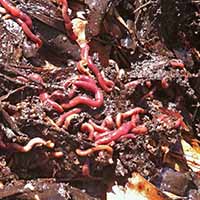Gardeners are likely to see a whole community of living things in their compost piles — from millipedes and roaches to worms and small mammals. While most of this activity is natural and great for compost, some uninvited guests can indicate a problem with the compost pile.
UGA Extension offers the Georgia Master Composter program, which suggests the following tips to guide gardeners through the complex ecosystem that is their backyard compost bin. This information is designed to help them identify potential composting pitfalls by keeping track of the bin’s residents.
Most are good guys
Most of the critters that gardeners see when they peer into their compost piles need to be there in order for compost to happen. Earthworms, white worms, sow bugs, pill bugs, millipedes, snails, slugs and mites all help break down the organic matter in the compost pile. They work with a web of microscopic organisms and fungi to turn garden and kitchen scraps into the black gold composters are after.
Other insects and invertebrates are there to eat this all-star team of decomposers, and that’s OK too. Centipedes, springtails, beetles and other predators add nutrients to the pile in other ways and keep the primary decomposer populations in check.
That said, when compost piles reach a certain stage in their decomposition, they become too hot to host many of these insects. So, an absence of insects is not necessarily a problem.
The bad guys
There are insects and animals that composters need to watch out for because they almost always indicate a problem with the compost bin.
Ants
Ants like to use dry, undisturbed soil for their nests. If you’re seeing a lot of ants in you pile, it’s likely that the pile is too dry and that you’re not turning it enough.
Compost piles work best when the entire pile is as damp as a wrung out sponge and should be turned at least once a week.
Fly Larvae, flies
Maggots, politely known as fly larvae, are often a sign that your compost is too wet or contains too much kitchen waste. They won’t harm the compost. However, if they become a nuisance, gardeners should try covering their compost during rainy periods in an effort to keep the pile a little drier.
Also, avoid “dump and run composting” to minimize the presence of flies. Whenever you add food scraps into your pile, be sure to bury them into the pile — don’t just dump it and leave it.
Centipedes
Centipedes usually appear in dry compost piles. They’re predators who feed on other insects in the pile. They are not a problem, but gardeners should keep an eye out because they can bite and sting if provoked.
Mice and rats
Mice and rats will visit your compost pile often if it’s a reliable source of kitchen scraps. If they become a problem, turn your pile more frequently and be sure to bury you food waste in the pile. If you continue to have a problem with mice and rats, you may want to stop adding food scraps to your pile for awhile, or use traps to control them.
Rodent-resistant bins are available for those who continue to have problems with mice and rats.
Snakes
Snakes only hang around compost bins if their preferred food source — rats and mice — can be found nearby. If gardeners see snakes coming out of their compost bins, it’s a good sign that they have a rodent problem. Turning the compost more often should solve both problems.
Possums and raccoons
Possums and raccoons are only after one thing: food scraps. Like with mice, turning the compost often and burying food scraps should cut down on nighttime visitors to the compost pile. However, some raccoons have been known to dig through a pile to find something that smells especially scrumptious.
This is one reason why composters should avoid putting meat scraps in their piles. To further dissuade raccoons from digging through compost, gardeners can use an enclosed plastic compost bin or line the sides, bottom and tops of their bins with wire mesh.
Keep a weighted lid on top of the pile if the raccoons in your neighborhood are particularly crafty.








